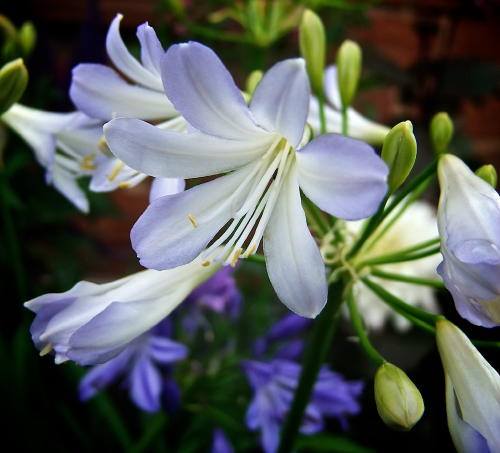The Ultimate Agapanthus Manual: Everything You Need to Find Out About Planting, Keeping, and Delighting In These Stunning Blossoms
Within the realm of gardening, couple of blossoms exude the beauty and appeal rather like agapanthus. The Ultimate Agapanthus Handbook offers as a thorough overview to assist you browse the globe of these magnificent blossoms, covering everything from picking the excellent selection for your yard to mastering the art of maintenance and treatment.

Agapanthus Ranges: Picking the Right One
When picking an Agapanthus variety, it is vital to take into consideration variables such as blossom shade, hardiness, and height to guarantee the right suitable for your garden. The blossom color of Agapanthus varies from tones of blue and purple to also bi-colored and white blossoms, offering a vast variety of options to enhance your yard's color system. Furthermore, height is a vital aspect to consider as Agapanthus selections can range from dwarf selections that remain under a foot tall to bigger varieties that can rise to 4 feet in height. Comprehending the height potential of your selected range is vital for proper positioning within your garden landscape. Furthermore, strength must be thought about to guarantee the Agapanthus variety can thrive in your particular environment problems. By meticulously reviewing these factors, you can select an Agapanthus variety that not just boosts the aesthetic appeal of your garden yet also flourishes in its setting.

Planting Tips for Healthy Growth
To make certain successful development and growth of Agapanthus plants, proper planting techniques are vital for establishing a healthy and balanced structure. Begin by selecting an ideal area that gets complete sun to partial shade, as Agapanthus flourishes in these conditions. The dirt ought to be well-draining to avoid waterlogging, which can bring about root rot. Before growing, change the soil with organic matter like compost to enhance its fertility and framework.
When growing Agapanthus, make sure the crown-- where the roots fulfill the stems-- is at soil degree (Agapanthus). Water recently planted Agapanthus deeply to assist the roots develop themselves.
Routine watering is crucial, specifically during the expanding season, to advertise healthy blooming. Fertilize Agapanthus in the spring with a well balanced fertilizer to sustain robust development and dynamic blossoms. By complying with these planting ideas, you can delight in flourishing and lovely Agapanthus plants in your garden.
Necessary Care and Upkeep Practices
Having established a solid foundation through proper planting techniques, the following crucial step for ensuring the health and vitality of Agapanthus plants hinges on carrying out important treatment and maintenance methods. Normal watering is important, especially during the growing period, to keep the soil continually moist however not saturated. Mulching around the base of the plants from this source can help maintain dampness and suppress weeds. Agapanthus plants take advantage of a well balanced plant food application in the springtime to support healthy and balanced development and dynamic flowers.
Agapanthus plants are generally low-maintenance but might benefit from regular inspection for bugs and illness. By following these essential treatment and maintenance practices, gardeners can appreciate the elegance of Agapanthus plants year after year.
Maximizing Blossoms: Feeding and Watering
Carrying out a tactical feeding and watering regimen is essential for making best use of the growing capacity of Agapanthus plants throughout the growing period. Agapanthus plants call for a well balanced approach to feeding and watering to create an abundance and prosper of attractive blooms. Utilizing a balanced plant food with a higher potassium material can advertise flower production when it comes to feeding. It is recommended to apply a slow-release fertilizer at the start of the growing season and afterwards supplement with a fluid fertilizer every 4-6 weeks throughout the active development period.
In regards to watering, Agapanthus plants like constantly damp but well-drained soil. Water deeply and rarely to urge deep origin development and prevent waterlogging, which can cause root rot. Throughout the hot summer months, boost watering regularity to make certain the plants receive a sufficient amount of wetness. Mulching around the plants can assist preserve dirt moisture and control soil temperature level. By following a consistent feeding and watering regular, you can guarantee that your Agapanthus plants prosper and produce a remarkable display of blooms.
Innovative Ways to Delight In Agapanthus Flowers
Cut Agapanthus blossoms can continue reading this be set up in a flower holder on their own or mixed with various other complementary blossoms to include a touch of style to any room. Growing Agapanthus in clusters along boundaries or pathways can develop a striking visual influence in your yard. Furthermore, you can make use of Agapanthus flowers to add a pop of shade to your patio area or veranda by positioning potted plants purposefully to brighten up your outside living areas.

Final Thought
In verdict, agapanthus blossoms are a beautiful enhancement you can try these out to any kind of yard, with a selection of varieties to select from. Get imaginative with how you appreciate agapanthus, whether in arrangements, arrangements, or as a focal point in your garden.

Agapanthus plants profit from a balanced plant food application in the springtime to sustain healthy development and vivid blossoms.
Applying a tactical feeding and watering regimen is essential for maximizing the growing potential of Agapanthus plants throughout the expanding period. Agapanthus plants require a well balanced method to feeding and watering to create an abundance and grow of lovely blooms. In addition, you can utilize Agapanthus flowers to include a pop of color to your patio or porch by putting potted plants strategically to brighten up your exterior living areas.
Comments on “Seasonal Agapanthus Care: Preparing for Winter and Summer”